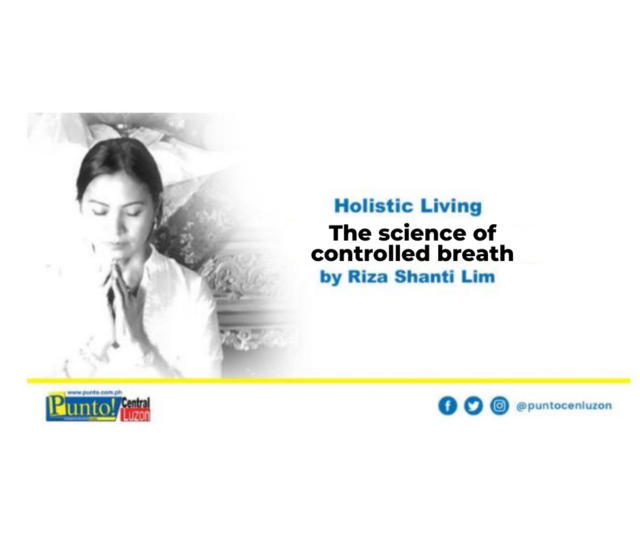DO YOU take deep breaths, whenever you feelanxious or nervous? Do you know that psycho-prophylactic method also popularly known as Lamaze technique, popularized since the 1950s by French obstetrician Dr. Ferdinand Lamaze, uses variations ofbreath works to expectant mothers, to reduce painassociated with natural birth? Do you realize that just by learning how to regulate the proper in-flow and out-flow breath, you could actually alter your state of being, yourself and your destiny?
Pranayama is the fourth step in the eight limbs of YogaSutras. Pranayama is a Sanskrit word, which means the science of controlled breath. Prana means life force or qi, while yama means control.
Prana is the energy that flows into your veins, to all living creations, throughout nature, to the entire universe. Where there is prana, there is life. When prana circulates naturally and freely in your body, you feel vibrant, healthy and strong. You will notice as your mind is centered and quiet, so is your breath.
When the mind is turbulent, your breathing becomes laborious and disordered, weakens the body systems, delivers you straight to the land of diseases, hence, miserable living condition follows.
The goal of pranayama is to harmonize your mind with your breath and develop that intimacy that conceives endless joys, here and hereafter. To recognize that your body and your mind are one and inseparable: that what the body experiences, the mind feels it too.
In hatha yoga, there are thousand kinds of pranayama, being used in health institutions in Europe, USA, Japan, India, Tibet, even in the Philippines. Each pranayama has a specific value that can be utilized to treat either a physical or mental unwellness,purification of the nadis (energy channels), and to induce peace in the mind.
My top choices pranayama
Anuloma Viloma is one of my favorite pranayamas. It is simple and relaxing. It involves a simple soundlessinhalation and exhalation, attention focused on the in and out flow of your breath, eyes gently closed. To heighten your calm, you may incorporate the “khumbhaka,” the process of holding your breath, either after an inhalation or after an exhalation, for five or ten counts, depending on your capacity. About fifteen cycles for beginners, adding more as you progress – in sitting or lying position.
Ujjayi pranayama also called victorious breath orocean breath, but I prefer to call it baby snore breathbecause of the similar sound it vibrates in the course of exhalation. Breathing in and out of the nose is the system used in ujjayi. It is popular among ashtanga or ashtanga vinyasa yoga practitioners, applied to support asanas (body postures). It is invigorating, enables theperformer to maintain his/her energy and rhythm, detoxifies the health functions through sweatingbecause of the heat it produces, and sets tranquility in the mind. Ujjayi pranayama, gives you that extra power, endurance and stability to execute challengingasanas with ease. Further, it oxygenates the body, a good preventive medicine.
My nightly ritual to assure me of a good rejuvenating sleep is “nadi shodhana pranayama” or alternate nostril breathing. To begin, sit comfortably on a chair, floor or bed. With your right hand, place your index and middle finger between your eyebrows. The right thumb and ring finger are used for this method, whereas your left hand is rested on your lap. Close your eyes and inhale and exhale deeply, about fivetimes. Press the right nostril with your right thumb, inhale through the left nostril, close the left nostril with your ring finger, release the right thumb to open the right nostril and exhale. Inhale from your right nostril, press to close the right nostril, open the left nostril and exhale. I usually recommend 9 rounds or 5 minutes in this subject for beginners, adding more rounds when you are ready. Nadi Shodhana, clears the impurities in the mind. It promotes serenity, sinusitis, relieves stress, improves sleep and brain functions.
Another helpful and safe pranayama to those who are suffering from emotional disturbance and depression is Bhramari pranayama. Bhramari is a Sanskrit word which means a black bumble bee. To begin, sit comfortably, relax and close your eyes. Inhale deeply and then for the entire length of your exhalation, make a low to medium pitched loud humming sound like a bee. Repeat the cycle six times and notice the difference. Continue as needed. Spiritual gurus in Tibet, India, Nepal, and Bhutan use bhramari method to activate their chakras (7 spiritual centers of the body) and to stimulate stillness.
As you master the law of giving and receiving through your constant practice of pranayama, you become aware that from the time you were conceived and took your first inhalation, you exchanged trillions of atoms with your surroundings in every breath that you take. And that your breath is your life sustenance. It is the only devoted companion who has been faithful and always there for you, until your last and to the next.
OM Samadhi





